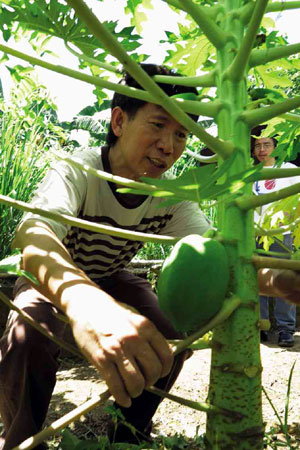Filipino farmers need to be techno-savvy

MAURICIO Sandico believes that a scientific approach to organic farming would boost farmers’ harvests and income. EV ESPIRITU
Filipino farmers, by and large, are hardworking and industrious. But in this globalization age when they have to compete with their counterparts in China and other countries, these traits are not enough.
Simply relying on conventional old practices, such as farming methods promoted by big agrochemical companies for decades, is not the way for today’s farmer to get by. Unless he innovates and maintains a sense of wonder for discovery, the conventional tiller will perish, according to a new breed of farmers.
Mauricio Sandico belongs to this new breed. He has the heart of both farmer and scientist and advocates organic food and a way of farming that can help regenerate the earth.
When he decided to shift his career to farming in 2007 after 24 years of being an overseas worker in the Middle East, Sandico first surveyed the organic food business terrain in Baguio City and neighboring areas.
His search led him to an already organized group—the La Trinidad Organic Practitioners or LaTOP, which was organized in 2005. The group now has more than 50 members.
Article continues after this advertisementLaTOP offers basic courses on organic farming, such as composting. Sandico availed himself of its training activities and eventually became a member.
Article continues after this advertisementIn applying what he learned, he would gather wild sunflower stems from Baguio and bring these to his newly acquired four-hectare organic farm in Rosario town in La Union province, an hour’s drive from the mountain city.
He would tear apart the sunflower stems with a shredding machine and mix these with other weeds to make compost. In two or more months, he could gather the compost materials for his crops, such as okra, string beans, eggplant, rice and lemongrass.
Too laborious
But Sandico found composting too laborious even if he has a shredder. “I also thought about other farmers who couldn’t afford to buy a shredder,” he said. “So I have to find a more efficient way [of making compost].”
A locally fabricated shredder costs P40,000 to P50,000.
Sandico’s search led him to discover dried seaweed as an alternative organic fertilizer. Dried seaweed is rich in nitrogen and potassium, which help plants grow faster and healthier.
So Sandico hired some fishermen to gather seaweed washed ashore in La Union after a storm. The seaweeds were then washed and rinsed with fresh water before these were dried and shredded.
From his experiments, he found that decomposed seaweed could not be used repeatedly for a long time. His conclusion: Decomposed seaweed could be used alternately with other kinds of compost.
But like the native sunflower from Baguio, preparing the seaweed for compost was equally tedious, laborious and costly. The expenses included hired labor to gather the seaweeds and rinse these with fresh water.
New wave
Still, this didn’t discourage Sandico to make organic farming part of the new wave of the future.
His persistent drive to discover other organic farming approaches led him to enlist in another seminar on how to make compost using beneficial microorganisms. Participants were taught how to make compost out of sawdust mixed with what is called a “microbial inoculant.”
The microbial inoculant was discovered as early as 1982 by Dr. Teruo Higa, a Japanese microbiologist. Higa called his discovery “effective microorganisms,” now popularly referred to as “EM.”
First used by organic farmers in Japan, EM is now marketed in liquid form. A small amount of it can be added to compostable material to make a highly potent organic fertilizer called bokashi.
In the seminar Sandico attended in 2010, trainers used sawdust to make bokashi. With an inquisitive scientific mind, he asked himself, “If sawdust could be used, why not rice bran?”
He thought of rice bran because these were readily available in his farm in Rosario since he also cultivates organic rice.
From the training where he learned some basics of making bokashi, he had to discover for himself the nitty-gritty of making the organic fertilizer using rice bran. After a series of experiments for almost a year, he said he perfected making bokashi out of rice bran only in 2011 and “after a series of trial and error.”
But since he could manufacture more than enough for his own farm, he is now selling the EM-enriched organic fertilizer. He launched his own version of bokashi fertilizer in November last year.
His research efforts have paid off. He now has a convenient source of organic fertilizer for his farm.
Sandico discovered that a small amount of bokashi, when mixed with animal feed, is good for poultry and livestock. A kilo can be mixed with 50 kilos of feeds, which, he said, assures a farmer of healthier hogs and poultry.
There’s an added bonus—the wastes of animals fed with bokashi mix don’t smell.
Bokashi is good for fishponds, too. It can be broadcast to a fishpond before one brings in the fingerlings, Sandico said.
In organic farming, he discovered one vital basic principle: Nurture and feed the soil by sustaining its beneficial microorganisms and trace elements. And these microorganisms will do their part in sustaining plants, which are healthier for both humans and animals.